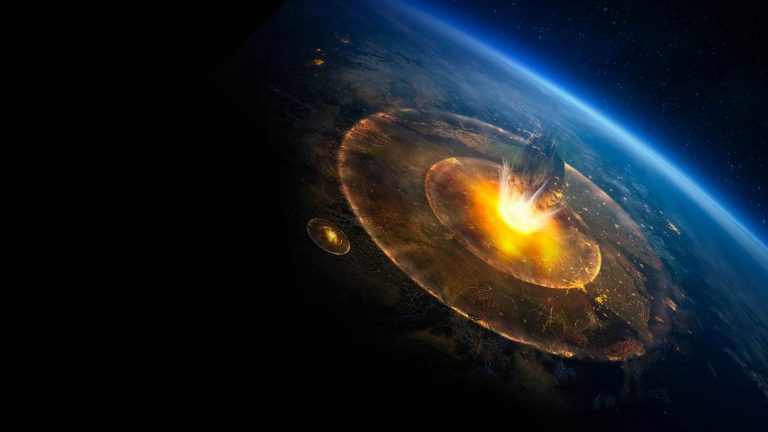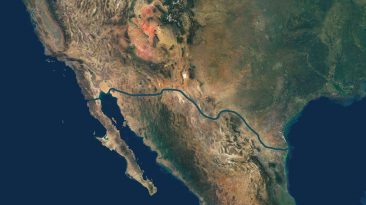Within the vastness of the Universe, humanity is not that big of a deal. We’re not here because we’re meant to be here, we’re just… here. If mathematical predictions are correct, we might only have 760 years left.
What would be the cause of our extinction? What would we do if we knew exactly when our existence will come to an end? Could we delay the inevitable?
In 1993, knowing that humanity’s time on the planet is limited, astrophysicist J. Richard Gott made a very daring prediction using nothing but statistics. Basically, he calculated that there is a 50% chance that the end of human life will come sometime before the year 2779.
That gives us 760 years to make our final arrangements, and possibly pass the Earth on to a new life form, or even leave the planet to itself altogether. Stick around, and we will take you on a journey to the future of humanity.
2029, 750 years before the extinction
99942 Apophis approaching the Earth. Calculating chance of collision… On April 13, 2029, the near-Earth asteroid named Apophis will pass within 31,000 km (19,300 mi) of our planet.
That’s ten times closer to Earth than the Moon is, and even closer than some satellites in orbit. But this 370-meter-wide (1,200 ft) asteroid won’t hit the Earth. Instead, it will sweep by safely and continue its path around the Sun.
2030, 749 years before the extinction
Reproductive technology would allow parents to preview and pick the genetic traits of their future babies. The global population would grow to about 8.5 billion, and reach a crisis point.
The world’s ecosystems would change faster than we’ve ever seen before, due to increased levels of CO2. Up in the Earth’s orbit, everything from spent rocket stages to debris from accidental collisions would create a wall of space junk.
It would become problematic for any spacecraft to leave the Earth. We would have to find ways to clean up the upper atmosphere if we didn’t want to be trapped on Earth forever.
If humanity managed to solve the space junk problem, we would start establishing the first lunar bases. That would mark the beginning of the permanent human presence outside of Earth.
2045, 734 years before the extinction
On Earth, the global average temperature would rise by 1.5°C (2.7°F), surpassing the “safe” limit. Even though humanity completely switched to clean energy sources, global warming would become catastrophic and hard to control.
Due to warmer global temperatures, the Great Barrier Reef would lose up to 90% of its corals. The Amazon rainforest would largely be destroyed by wildfires and deforestation. Even after decades of conservation efforts, at least one million species in the wild would begin to go extinct.
This would be the beginning of the next mass extinction event in the Earth’s history. Although, this time, it would be caused by humans.
2056, 723 years before the extinction
The Earth’s population would grow to 10 billion people. The Earth would become the hottest it’s been in the past 3 million years. Extreme weather would rampage around the world.
Africa, the Middle East and Southeast Asia would be most affected by floods, hurricanes and droughts. Parts of the planet would become uninhabitable, leaving 140 million people no other choice but to seek refuge someplace else.
2080, 699 years before the extinction
Biotechnology implants would become available to the general public, resulting in humans merging with their technology on a biological level. Never-failing artificial organs, synthetic blood and nanoscale brain interfaces would become a new reality.
2099, 680 years before the extinction
Sea levels would rise upwards of 6 meters (20 feet), forcing hundreds of millions of people to leave their homes. Large-scale evacuations and resettlement programs would be needed along the coastlines, costing humanity trillions of dollars in the process.
Because of the declining fertility rate and the significant number of casualties from environmental conditions, Earth’s population would stabilize at 11 billion people.
2180, 599 years before the extinction
By the 2180s, humanity would start expanding into the Solar System. Mining asteroids and terraforming Mars would be underway. More people would have access to space technology, and a new form of terrorism would emerge.
It would be possible to hijack a spacecraft, and use it to redirect asteroids towards the Earth, the Moon and Mars. The lack of space infrastructure would leave space colonies particularly vulnerable.
2280, 499 years before the extinction
Spaceships powered by antimatter propulsion would take humanity outside the Solar System. Automated, unmanned probes would be sent to the far regions of the galaxy, researching thousands of interstellar worlds. By the end of the 23rd century, humans would have confirmation of microbial alien life existing on a warm, wet exoplanet within 100 light-years of our Solar System.
2300, 479 years before the extinction
Decades of nanotechnology research and advancement would result in transforming the general public into transhumans, or cyborgs. Transhumans would have improved intelligence and strength.
Among many superhero traits, they would be able to sprint at very high speeds, become invisible, or even transform their appearances at will. Although some people would choose to have minimal upgrades and stay as natural as possible.
2500, 279 years before the extinction
Humanity would level up from a type 0 to a type l civilization on the Kardashev Scale. That means that humans would be able to harvest all of the Earth’s energy, and use it to power up their entire civilization.
They would already be able to control the weather and global climate, alter the course of earthquakes and build cities at the bottom of the ocean. The next step would be developing ways to fully manipulate the Sun’s energy. They might start building space megastructures like a Dyson Sphere, or even attempt to feed some of the Sun’s mass into a black hole.
2779, 0 years before the extinction
The chain of the previous events could lead to humanity completely disappearing from the Earth, one way or another. We might end up moving to space colonies we had established. Or, it may not even be us anymore, but a new, biotechnologically engineered species.
Of course, this is a rough timeline, guesstimated by futurists, based on statistics and mathematical models. If you’re upset about humanity’s coming extinction, remember that it only has a 50% chance of coming true.
Scientists calculated our date of extinction using the same formula that marketers use to predict what product you might click on online, or who you are going to vote for. It’s about probabilities, not guarantees.
Besides, other predictions tell us that we would face extinction not 760 but 10,000 years from now. In that case, we’d be around long enough to see the Earth’s poles reverse around the year 3,500, and computers reaching their ultimate potential sometime after the year 4,000.
But how would knowing all this change the way we live our lives? If we knew the date of our extinction with 100% accuracy, we could stop caring about our environment and our bodies. We might focus on all the bad habits that only bring us short-term happiness.
Our society could become more violent, more self-harming, more inclined to start wars. Or, we could team up and try to get off this rock.
We could start looking for other places to move to, beyond what our own Solar System has to offer. We could establish colonies with stable human populations. Then, even in the event of Earth getting wiped out by some cosmic power, humans would continue to exist.
Subscribe to What-If on Youtube or follow the show on Facebook Watch.
Sources
- “‘Doomsday’ Math Says Humanity May Have Just 760 Years Left”. Poundstone, William. 2019. WSJ. Accessed October 6 2019.
- “A Math Equation That Predicts The End Of Humanity”. William Poundstone, 2019. Vox. Accessed October 6 2019.
- “Implications Of The Copernican Principle For Our Future Prospects”. Gott, J. Richard. 1993. Nature 363 (6427): 315-319. Springer Nature. doi:10.1038/363315a0.
- “What If We Knew When And How We’d Die?”. Nuwer, Rachel. 2019. bbc.com. Accessed October 6 2019.
- “5 Plans To Head Off The Apophis Killer Asteroid”. David Noland, 2006. Popular Mechanics. Accessed October 6 2019.
- “IVF Couples Could Be Able To Choose The ‘Smartest’ Embryo”. Devlin, Hannah. 2019. The Guardian. Accessed October 6 2019.
- “Tentacled Clamps, Net And Harpoons: How The UK Is Leading The Way On Space Junk Clean-Up”. Hoggins, Tom. 2019. The Telegraph. Accessed October 6 2019.
- “New Data About The Moon May Help Create Lunar Bases”. 2019. Solar System Exploration Research Virtual Institute. Accessed October 6 2019.


















